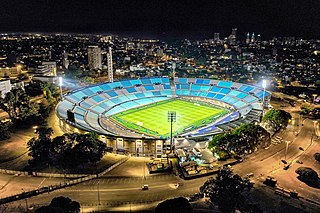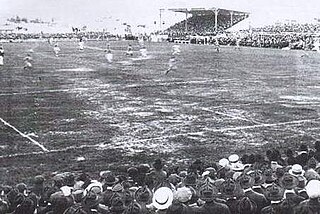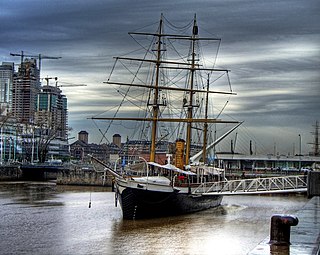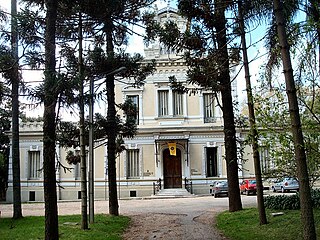
Montevideo is the capital and largest city of Uruguay. According to the 2011 census, the city proper has a population of 1,319,108 in an area of 201 square kilometers (78 sq mi). Montevideo is situated on the southern coast of the country, on the northeastern bank of the Río de la Plata.

Tourism in Spain is a major contributor to national economic life, contributing to about 12.4% of Spain's GDP. Ever since the 1960s and 1970s, the country has been a popular destination for summer holidays, especially with large numbers of tourists from the United Kingdom, Ireland, France, Germany, Italy, the Benelux, and the United States, among others. Accordingly, Spain's foreign tourist industry has grown into the second-biggest in the world.

A maritime museum is a museum specializing in the display of objects relating to ships and travel on large bodies of water. A subcategory of maritime museums are naval museums, which focus on navies and the military use of the sea.

Estadio Centenario is a stadium in the Parque Batlle of Montevideo, Uruguay, used primarily for staging football matches. It is owned by the Montevideo Department. The stadium was built between 1929 and 1930 to host the inaugural 1930 FIFA World Cup, as well as to commemorate the centenary of Uruguay's first constitution. It is listed by FIFA as one of the football world's classic stadiums. On 18 July 1983, it was declared by FIFA as the first Historical Monument of World Football, to this day the only building to achieve this recognition worldwide.

Estadio Pocitos was a multi-use stadium located in the Pocitos district of Montevideo, Uruguay. The stadium, owned by C.A. Peñarol, was mainly used for football matches from 1921 to 1933. It was demolished later in the 1930s when Peñarol started to play in the Estadio Centenario as its home field, and additionally due to the increasing urbanisation of Montevideo.

Pocitos is an upscale seaside barrio of Montevideo, Uruguay. It borders Buceo to the east, Parque Batlle to the north, Tres Cruces, Cordón and Parque Rodó to the west and Punta Carretas to the south.

The Montevideo Cabildo is the public building in Montevideo that was used as the government house during the colonial times of the Viceroyalty of the River Plate. Today the building is used as a museum and houses the Historical Archive of the city. It is located on Constitution Square, in Ciudad Vieja.

The Rambla of Montevideo is the coastal avenue that goes along the coastline of the Rio de la Plata in Montevideo, Uruguay. At a length of over 22.2 uninterrupted kilometres (13.7 mi), the promenade runs along the Río de la Plata and continues down the entire coast of Montevideo. Since most of the southern departments of Uruguay face either the Río de la Plata or the Atlantic Ocean, they all have ramblas as well. The Rambla is an integral part of Montevidean identity and has been proposed as a World Heritage site.

Buceo is a barrio in Montevideo, Uruguay.

Tres Cruces is a barrio of Uruguay's capital Montevideo. Its name means "three crossings", referring to the three major transportation routes which intersect in the area: Avenida 18 de Julio, Bulevar Artigas and Avenida 8 de Octubre. It is also the starting point of Italia Avenue.

The corbeta (corvette) ARA Uruguay, built in England, is the largest ship afloat of its age in the Armada de la República Argentina, with more than 140 years passed since its commissioning in September 1874. The last of the legendary squadron of President Sarmiento, the Uruguay took part in revolutions, ransoms, expeditions, rescues, and was even floating headquarters of the Navy School. During its operational history 1874–1926 the Uruguay has served as a gunboat, school ship, expedition support ship, Antarctic rescue ship, fisheries base supply ship, and hydrographic survey vessel, and is now a museum ship in Buenos Aires. The ship was built in 1874 at Laird Bros. shipyard of Birkenhead, England, at a cost of £32,000. This ship is rigged to a barque sailplan. The ship's steel hull is sheathed in teak.

Parque Rodó is both a barrio of Montevideo, Uruguay and a park which lies mostly outside the limits of the barrio itself and belongs to Punta Carretas. The name "Rodó" has been given in memory of José Enrique Rodó, an important Uruguayan writer whose monument is in the southern side of the main park.

Punta Carretas is a barrio of Montevideo, Uruguay.

Paso de las Duranas is a cultural center in Montevideo, Uruguay.

The Carnival Museum is located at 25 De Mayo Street in the "Ciudad Vieja" in Montevideo, Uruguay. It was built in November 2006.

The Museum of the Sea, opened in 1996, is a museum of natural history located in La Barra, in the department of Maldonado, Uruguay. It occupies about 2,300 m2 (25,000 sq ft) and is divided into four large halls, which are open to the public all year round.
Equipo Continental Municipalidad de Pocito is an Argentinian UCI Continental cycling team founded in 2010.

The Museum of Pre-Columbian and Indigenous Art is an ethnographic museum located in Ciudad Vieja, Montevideo, Uruguay, dedicated to the indigenous cultures of different parts of Latin America.

















